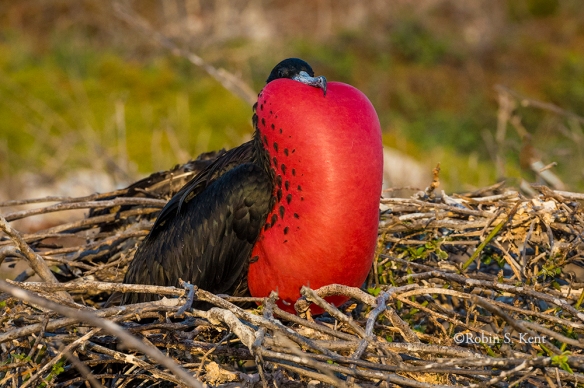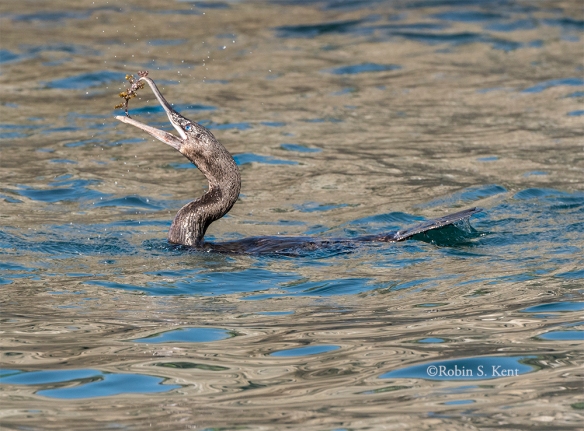 Sunrise on the Equator, Pacific Ocean
Sunrise on the Equator, Pacific Ocean
The Galapagos Islands are a chain, or archipelago, formed by volcanic action over the past 5 million years. Located on the equator about 600 miles west of Ecuador. But what makes them special is the unique array of wildlife that is found there. Many of the species are found nowhere else on earth and, because they lack natural predators, most have no fear of the thousands of tourists (even photographers) who come to see them every year.

Galapagos Land Iguana, Feeding on Succulents
The Galapagos Land Iguana is primarily an herbivore, feeding mostly on cacti and other succulents and thus can go for long periods without drinking water. This species can weigh up to 13 pounds and they can live for as long as 50 to 60 years. The female lays up to 20 eggs in burrows they have excavated.

There are two kinds of frigatebirds on the islands, but the males of both variants possess the distinctive red throat pouch which inflates into enormous heart-shaped balloons. It can take up to 30 minutes for the pouch to completely fill as the male hopes to enthrall a passing female.
 Frigatebird Carrying Nesting Material
Frigatebird Carrying Nesting Material
Nesting occurs in colonies that may include members of both variants. The nests are constructed mostly by the female with materials brought in by the male. The birds can have wing spans of 7 feet.
C Young Frigatebird Chick on Nest
Young Frigatebird Chick on Nest
The female lays only one egg and it may take 40-50 days to hatch. Both parents share in the nesting and feeding after hatching. It will take another 20-24 weeks before the juvenile fledges but they continue to be fed for another 20 weeks or more before they fend for themselves. Because of the length of this cycle, the female can reproduce only once a year at the most.

Galapagos Flightless Cormorant Drying “Wings”
The Flightless Cormorant is unique to the Galapagos and is found on only two of the islands. Only 1,000 breeding pairs exist. Having no land-based predators, natural selection favored those birds that were better built for swimming and diving. Their wings are about 1/3rd the size needed to fly.
 Flightless Cormorant with a Catch
Flightless Cormorant with a Catch
Their courtship is unusual because it is the female that aggressively seeks out the male, and subsequently will depart her partner and offspring to re-mate serially with different males while males raise the young by themselves.
 Sally Lightfoot Crab (Yes, really!)
Sally Lightfoot Crab (Yes, really!)
Winner of my award for the creature with the best name (barely edging out the blue footed booby), the colorful Sally Lightfoot Crab is a common sight in the Galapagos Islands. According to one source, this little beastie is named after a famous Caribbean dancer because of its incredible agility. I don’t know about the namesake, but these guys are quick.
 Wave Breaking in Late Afternoon Light
Wave Breaking in Late Afternoon Light
Next: Galapagos Islands (Part 2)

Great natural history shots. That brightly coloured crab is particularly delightful.
LikeLike
Thanks, Laura! That crab was so colorful, I thought it was a new product from toys r us!
LikeLiked by 1 person
Beautiful creatures in this long awaited post Robin. Brilliant colours on the Frigate and the crab!
LikeLiked by 1 person
Thanks, Chris! Been having some troubles with WordPress, regarding getting access to my site and being able to like/comment on others. Finally figured a work-around today. But I’m glsd you liked it.
LikeLike
Great Post Robin!
LikeLiked by 1 person
Thanks, Michele!
LikeLike
Superb photos, Robin! The sunset shot was especially striking. And that crab! I had no idea those existed.
LikeLiked by 1 person
Hey, Greg. Thanks very much. I know what you mean. The first one that I saw made me think of that Transformers movie, it was too colorful to be real. You’ll notice my reply here is coming via Facebook (ugh!) which is one of the work-arounds I am using to get access to my WordPress account. Something wrong with their records on who I am. It’s always something;-)
LikeLike
Such an amazing place! Love the picture of the chick. And that crab is really something else! Glad you figured out a work around for WP!
LikeLiked by 1 person
Thanks for commenting! Still working on the glitch, but I have a few back-door ways to get access. Just cumbersome is all. Anyway, glad you liked the chick, I was about 15-20 feet away and the female seemed totally unworried about it.
LikeLiked by 1 person
Must have been a very cool experience!
LikeLiked by 1 person
It definitely was that. I have never encountered such a wide diversity of wildlife in such a small area.
LikeLike
Wonderful! Your images transported me there 🙂
LikeLiked by 1 person
Thanks! That is very kind of you to say.
LikeLiked by 1 person
Galapagos certainly has some interesting wildlife and you have done a fantastic job capturing it! That crab is amazing. Love the last wave breaking image too!
LikeLiked by 1 person
Thanks, Denise! I appreciate that very much. The waves were really nice that evening with the low light from the sun. After spending a few minutes trying to get the shot, I had to hustle to catch up with the group. Sure didn’t want to miss the last zodiac back to the ship;-)
LikeLike
These images bring back such great memories of my visit there in 2004. Your Sally Lightfoot is an amazing shot!
LikeLiked by 1 person
Thanks so much. Glad I brought back some good memories. Yes, that crab was pretty impressive, still can’t figure out why it has all those colors.
LikeLiked by 1 person
😊
LikeLike